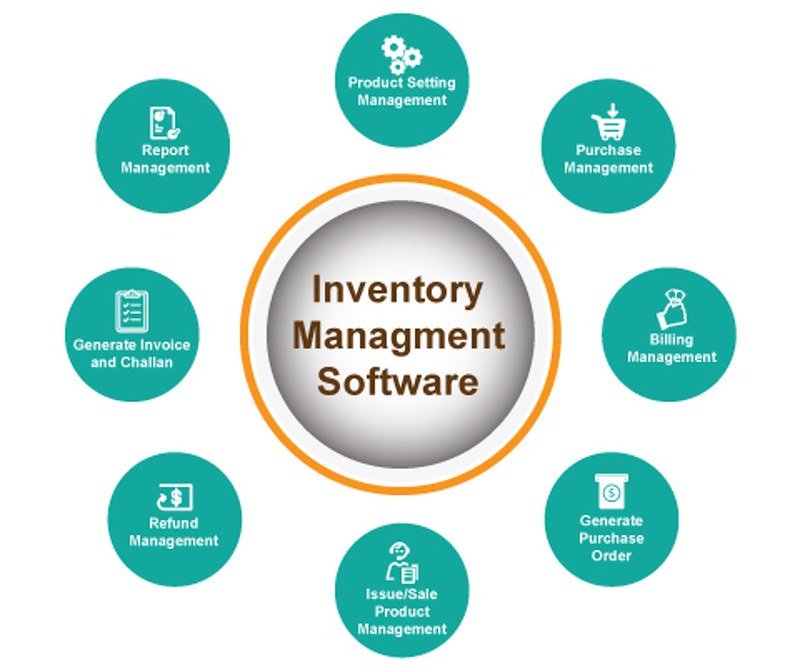Unraveling the captivating dance between supply and demand lies the secret to a successful business venture. Picture this: a harmonious symphony of organizational prowess, where every item is precisely accounted for, and every order is met effortlessly. Inventory management, the unsung hero of businesses far and wide, holds the key to unlocking a world of prosperity and growth. In this article, we embark on a journey through the labyrinthine realm of inventory management, delving into its intricacies and enlightening you with its profound importance. Brace yourself, as we uncover the hidden gems and unravel the mystical tapestry that is inventory management – the true cornerstone of business success.
Table of Contents
- The Importance of Effective Inventory Management Strategies
- Streamlining Inventory Processes for Increased Efficiency
- Integrating Technology Solutions to Optimize Inventory Control
- Implementing Data Analysis Tools for Accurate Demand Forecasting
- Q&A
- To Wrap It Up

The Importance of Effective Inventory Management Strategies
Inventory management is a vital aspect of running a successful business. It involves tracking and controlling the flow of materials and products from suppliers to warehouses, and eventually to customers. Adopting effective inventory management strategies can have a profound impact on various aspects of your business. Let’s delve into some key reasons why prioritizing inventory management is crucial for business success.
1. Reducing Costs: Effective inventory management helps reduce unnecessary costs associated with excess stock or stockouts. By carefully analyzing demand patterns and maintaining optimal stock levels, businesses can minimize the risk of holding obsolete inventory and avoid incurring additional storage costs.
2. Enhancing Customer Satisfaction: Efficient inventory management ensures products are readily available to meet customer demand. By having the right products in stock, businesses can prevent frustrating stockouts and delays in order fulfillment. This leads to improved customer satisfaction, increased customer loyalty, and ultimately, a boost in sales.

Streamlining Inventory Processes for Increased Efficiency
Efficient inventory management is crucial for the success of any business. In order to meet customer demands, minimize costs, and maximize profits, businesses need to optimize their inventory processes. Streamlining these processes can lead to increased efficiency, improved productivity, and ultimately, a competitive edge in the market.
Here are some key strategies to streamline inventory processes and enhance overall business efficiency:
- Regularly track and analyze inventory data: Utilize inventory management software to keep track of inventory levels, sales trends, and customer preferences. By analyzing this data, businesses can identify patterns, predict demand, and make informed decisions about purchasing and stocking.
- Implement a just-in-time (JIT) inventory system: JIT is a popular inventory management technique that aims to reduce holding costs and minimize the risk of stockouts. By ordering and receiving inventory only when needed, businesses can optimize their stock levels and eliminate excess inventory.
- Utilize automation and barcoding: Implementing automated solutions like barcode scanning and inventory tracking systems can greatly improve accuracy and efficiency. These technologies help reduce manual errors, simplify order fulfillment, and enable real-time inventory management.
- Optimize warehouse layout and organization: Designing an efficient warehouse layout and organizing inventory strategically can save time and effort during picking, packing, and shipping processes. Grouping similar products together and using clear labeling systems can minimize searching time and improve order fulfillment speed.
Remember, effective inventory management is not a one-time task, but an ongoing process. By continuously evaluating and improving inventory processes, businesses can drive operational efficiency, reduce costs, and deliver a seamless customer experience.

Integrating Technology Solutions to Optimize Inventory Control
Effective inventory management is essential for any successful business. It ensures a smooth flow of products, avoids stockouts, and maximizes profitability. However, as companies grow and expand, managing inventory manually becomes more challenging and time-consuming. That’s where integrating technology solutions can be a game-changer.
By harnessing the power of advanced inventory control systems and automation, businesses can streamline processes, enhance accuracy, and improve overall productivity. Let’s explore how integrating technology solutions can optimize inventory control:
- Real-time visibility: Implementing a robust inventory management software provides real-time access to inventory levels, enabling businesses to make data-driven decisions. Automated alerts can also be set to notify when stocks reach critical levels, preventing stockouts or excess inventory.
- Demand forecasting: Through the integration of predictive analytics and machine learning algorithms, technology solutions can analyze historical data, customer trends, and market conditions to accurately forecast future demand. This allows businesses to optimize inventory levels, avoiding overstocking or inventory shortages.
- Efficient order management: By automating order processing and fulfillment, technology solutions can reduce manual errors and streamline the entire order management cycle. This ensures timely delivery and customer satisfaction while optimizing inventory allocation.
- Barcode scanning and tracking: Leveraging barcode technology, businesses can easily track and manage inventory movement. By scanning barcodes, employees can update inventory records in real-time, improving accuracy and minimizing discrepancies.
- Integration with suppliers: Seamless integration with suppliers through electronic data interchange (EDI) or application programming interfaces (APIs) can significantly enhance inventory control. Real-time data exchange allows for better inventory visibility, just-in-time deliveries, and efficient replenishment.
- Just-in-time inventory: Technology solutions enable businesses to adopt a just-in-time (JIT) inventory strategy. By receiving inventory only when needed, companies can reduce storage costs, minimize product obsolescence, and optimize cash flow.

Implementing Data Analysis Tools for Accurate Demand Forecasting
Accurate demand forecasting is crucial for effective inventory management, which in turn is the key to business success. By utilizing data analysis tools, businesses can gain invaluable insights into customer behavior, market trends, and historical sales data to make informed decisions about inventory levels and product availability. Here, we explore the benefits of implementing data analysis tools for demand forecasting and how they can revolutionize your inventory management strategy.
1. Improved inventory control: Data analysis tools enable businesses to analyze past sales data and identify patterns and trends. By understanding the relationship between sales and various factors such as seasonality, promotions, or customer behavior, businesses can improve their inventory control and optimize supply chain operations. This helps to eliminate understocking or overstocking, reducing carrying costs and ensuring that products are available when customers demand them.
2. Enhanced customer satisfaction: Accurately forecasting demand means businesses can better anticipate customer needs and ensure their products are readily available. By using data analysis tools, businesses can identify demand patterns, peak periods, and fluctuations, allowing them to allocate resources efficiently and deliver an exceptional customer experience. For instance, an e-commerce platform can predict increased demand during holiday seasons and proactively optimize inventory and shipping processes to meet customer expectations.
Q&A
Q: Why is inventory management important for business success?
A: Inventory management plays a crucial role in business success as it allows companies to efficiently track, control, and optimize their stock of goods. By effectively managing inventory, businesses can reduce costs, meet customer demand, improve cash flow, and increase overall profitability.
Q: What are the benefits of implementing effective inventory management strategies?
A: By implementing effective inventory management strategies, businesses can experience numerous benefits. These include minimizing stockouts and overstocking, reducing carrying costs, improving order fulfillment rates, enhancing customer satisfaction, and ultimately gaining a competitive edge in the market.
Q: How does inventory management impact customer satisfaction?
A: Inventory management directly affects customer satisfaction by ensuring that products are available when customers need them. Efficient management helps prevent stockouts, enabling businesses to meet customer demand promptly. Additionally, accurate inventory tracking prevents delays and errors, leading to improved order fulfillment rates and enhanced customer experiences.
Q: How can effective inventory management reduce costs?
A: Effective inventory management can significantly reduce costs for businesses. By closely monitoring stock levels, companies can avoid overstocking, which ties up capital and increases holding costs. Furthermore, having accurate data on inventory allows businesses to minimize the risk of stock obsolescence and spoilage, further reducing expenses.
Q: What role does technology play in modern inventory management?
A: Technology plays a pivotal role in modern inventory management systems. Various software solutions and automation tools enable businesses to streamline their inventory processes, such as real-time tracking, forecasting, and automatic replenishment. These advancements not only improve efficiency but also provide valuable insights that aid decision-making in inventory management.
Q: How does inventory management impact cash flow?
A: Inventory management directly impacts cash flow as it helps businesses reduce the risk of excess and obsolete stock, enabling them to allocate resources effectively. By optimizing order quantities and accurately predicting demand, companies can prevent stockouts and keep cash available for other critical business operations, enhancing overall cash flow stability.
Q: Can successful inventory management positively influence profit margins?
A: Absolutely! Successful inventory management has a direct impact on profit margins. By minimizing carrying costs, reducing waste, and preventing the loss of sales due to stockouts, businesses can operate more efficiently and improve their overall profitability. Accurate inventory management allows companies to invest resources in other profit-generating activities, ultimately boosting their bottom line.
Q: How can businesses ensure effective inventory management?
A: Businesses can ensure effective inventory management by implementing a few key practices. These include regular inventory audits, accurate demand forecasting, establishing robust relationships with suppliers, utilizing inventory management software, adopting just-in-time (JIT) inventory principles, and actively training employees on relevant procedures. By combining these strategies, businesses can establish a solid foundation for successful inventory management.
Q: Are there any potential challenges in implementing inventory management systems?
A: Implementing inventory management systems may come with challenges such as technological integration issues, gathering and analyzing accurate data, and adapting to new processes. It may require initial investment and change management efforts. However, the benefits of efficient inventory management far outweigh these challenges, making it a worthwhile endeavor for businesses aiming for long-term success.
Q: How can businesses measure the performance of their inventory management?
A: To measure the performance of their inventory management, businesses can track key performance indicators (KPIs) such as inventory turnover ratio, stock accuracy, order fulfillment rate, and carrying costs. Regular monitoring and analysis of these metrics provide insights into the efficiency and effectiveness of inventory management strategies, enabling businesses to make informed decisions and continually improve their operations.
To Wrap It Up
As we reach the end of this journey through the intricate world of inventory management, we hope you have gained valuable insights into the key to business success. From the unsung hero hidden on warehouse shelves to the strategic weapon that can revolutionize your operations, inventory management has proven its worth time and time again.
In a highly competitive landscape where margins are slim and customer expectations are soaring, efficient inventory management has become a non-negotiable factor for success. It is the lighthouse guiding businesses towards profitability, harmonizing supply with demand, and paving the way for growth.
Embracing a well-crafted inventory management system enables businesses to navigate the treacherous waters of demand volatility, bolster customer satisfaction, and unlock hidden opportunities for cost savings. By merging the art of accurate forecasting with the science of optimized stock levels, businesses can strike the perfect equilibrium, where excess stock no longer burdens cash flow, and stockouts become mere relics of the past.
Beyond its immediate impact on sales and operations, robust inventory management plays a pivotal role in nurturing healthy relationships with suppliers and partners. Clear visibility into stock levels fosters transparency and trust, enabling businesses to establish long-lasting partnerships built on mutual reliability. It is the adhesive that binds together disjointed supply chains, transforming them into well-oiled machines capable of tackling the toughest challenges.
But let us not forget the untold story of inventory management. Amidst the numbers, spreadsheets, and warehouse racks lies a tale of dedication, innovation, and resilience. It is a silent art that requires constant vigilance, adaptability, and a keen eye for detail. Sometimes thankless, but always essential, the individuals behind the scenes who master the art of inventory management deserve our utmost respect.
As we bid farewell to this exploration of inventory management’s intricacies, we invite you to embark on a quest to unleash its true potential within your organization. Embrace the power of data-driven decision-making, harness the cutting-edge technologies that have stormed the industry, and empower your teams to streamline processes and drive efficiency.
Remember, behind every successful business lies a meticulously managed inventory, ready to conquer the challenges of a dynamic marketplace. So venture forth, armed with the knowledge and tools bestowed upon you by this enlightening journey, and unlock the treasure trove that is inventory management, on your path to everlasting success.

